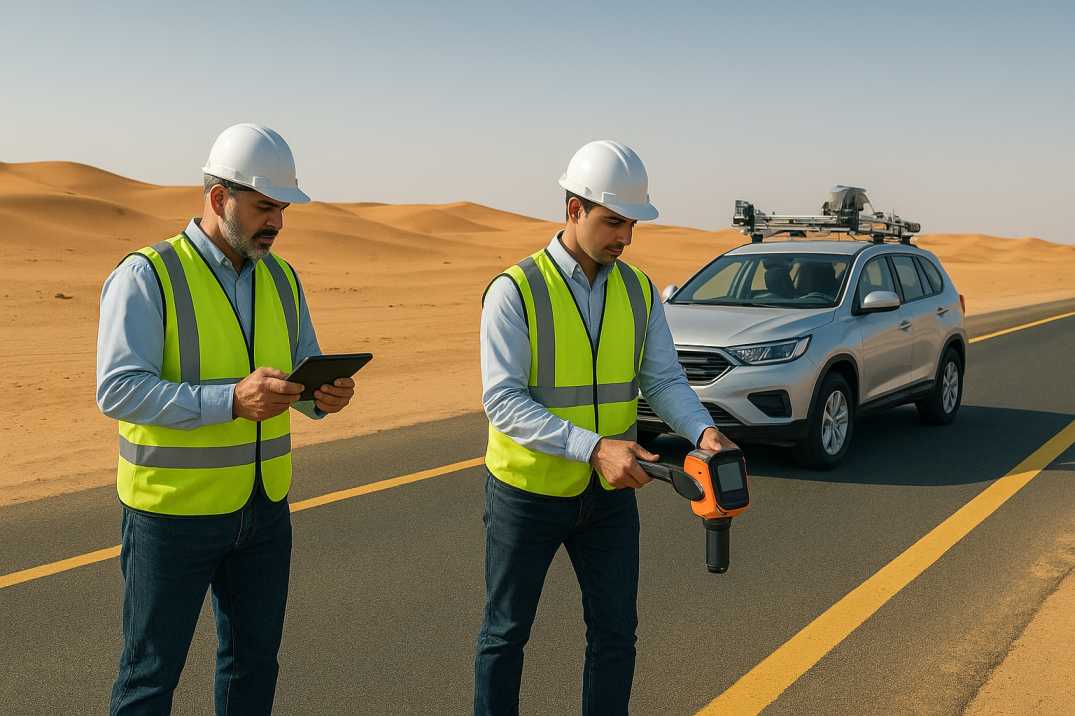Contact Us
RoadVision AI
Private Limited
Office No. 308 & 310, B Block
Ansal Chamber - 1, Bhikaji Cama Place,
Near Engineers India Limited (EIL) Bhawan, New Delhi - 110066
© 2024 | RoadVision AI | All rights reserved
Saudi Arabia is investing heavily in modern infrastructure under Vision 2030, with expressways and highways forming the backbone of national development. To maintain this critical network, advanced technologies such as AI pavement monitoring and automated pavement condition survey are being integrated into modern road asset management Saudi Arabia strategies.
Traditional manual inspections are no longer sufficient for a country where extreme desert conditions, heavy freight loads, and rapid urbanization accelerate pavement deterioration. This is where AI-integrated pavement structural health monitoring plays a vital role in ensuring long-term durability and compliance with Saudi transportation standards. By adopting AI road monitoring KSA solutions, authorities can move from reactive maintenance to predictive and preventive strategies, saving costs and improving safety.

Saudi expressways face unique challenges. High axle loads from freight transport, fluctuating day-to-night temperatures, and sand intrusion all affect pavement performance. According to the Saudi Ministry of Transport and Logistic Services (MOTLS) and requirements outlined in the Saudi Road Design Manual, continuous monitoring of pavement distress and structural performance is mandatory.
Pavement structural health Saudi Arabia is therefore crucial to protecting infrastructure investments. With digital pavement monitoring system powered by artificial intelligence, authorities can conduct faster, more reliable, and objective assessments across thousands of kilometers of highway.
AI pavement monitoring is transforming road asset management Saudi Arabia. Instead of relying only on scheduled manual inspections, AI models process continuous pavement data collected through sensors, imaging, and LiDAR.
Key applications include:
By embedding AI into asset management frameworks, engineers can prioritize interventions, optimize budgets, and ensure compliance with Saudi MOTLS regulations.
The digital pavement monitoring system integrates multiple technologies into one platform:
This holistic approach ensures expressways are continuously monitored and maintenance is optimized based on data-driven insights.
Implementing AI pavement monitoring in Saudi expressways provides measurable benefits:
The future of road asset management Saudi Arabia lies in smart technology adoption. With AI-based pavement monitoring, digital pavement monitoring systems, and automated pavement condition surveys, Saudi Arabia is positioning itself as a leader in sustainable infrastructure. By integrating AI with structural health monitoring, the country can ensure expressways that last longer, cost less to maintain, and meet the safety expectations of Vision 2030.
RoadVision AI is revolutionizing road infrastructure development and maintenance by leveraging cutting-edge AI in road safety and computer vision technology. Through advanced digital twin technology, the platform performs comprehensive road safety audits, enabling early detection of potholes, cracks, and other surface issues, ensuring timely repairs and improved road conditions. It also enhances traffic surveys by providing data-driven insights to address challenges like traffic congestion and optimize road usage. With a focus on building smart roads, RoadVision AI ensures full compliance with IRC Codes, empowering engineers and stakeholders to reduce costs, minimize risks, and improve the overall road safety and transportation experience.
To explore how these technologies can be implemented for your projects, book a demo with us.
Q1. What is AI-integrated pavement structural health monitoring?
It is the use of AI, sensors, and computer vision to monitor cracks, load impact, and structural health of pavements in real-time for more efficient maintenance.
Q2. Why is pavement health monitoring important in Saudi Arabia?
Saudi Arabia’s expressways face harsh desert conditions and heavy freight loads. Continuous monitoring ensures safety, cost savings, and compliance with Vision 2030.
Q3. How does an automated pavement condition survey benefit road authorities?
It enables faster, accurate, and objective assessment of pavement health, reduces manual errors, and provides actionable insights for better road asset management.